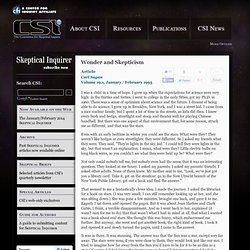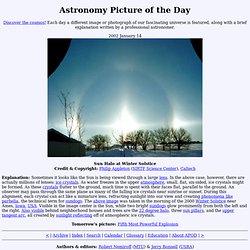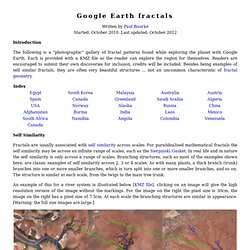

Galactic Center Mosaic by Stéphane Guisard/ESO, Los Cielos de Chile. Wonder and Skepticism. Article Carl Sagan Volume 19.1, January / February 1995 I was a child in a time of hope.

I grew up when the expectations for science were very high: in the thirties and forties. I went to college in the early fifties, got my Ph.D. in 1960. Even with an early bedtime in winter you could see the stars. Not only could nobody tell me, but nobody even had the sense that it was an interesting question. That seemed to me a fantastically clever idea. It was in there. I sensed awe. It seemed the most exciting thing to study. It’s been my enormous good luck—I was born at just the right time—to have had, to some extent, those childhood ambitions satisfied. Science is still one of my chief joys.
There’s another reason I think popularizing science is important, why I try to do it. We have a civilization based on science and technology, and we’ve cleverly arranged things so that almost nobody understands science and technology. The predictive powers of some areas, at least, of science are phenomenal. 12 Events That Will Change Everything, Made Interactive: Scientific American. We are star stuff. Astronomy picture of the day. 2002 January 14 - Sun Halo at Winter Solstice. Discover the cosmos!

Each day a different image or photograph of our fascinating universe is featured, along with a brief explanation written by a professional astronomer. 2002 January 14 Sun Halo at Winter Solstice Credit & Copyright: Philip Appleton (SIRTF Science Center), Caltech Tomorrow's picture: Fifth Most Powerful Explosion Authors & editors: Robert Nemiroff (MTU) & Jerry Bonnell (USRA)NASA Technical Rep.: Jay Norris. How to Trick Your Brain for Happiness. This month, we feature videos of a Greater Good presentation by Rick Hanson, the best-selling author and trailblazing psychologist.

In this excerpt from his talk, Dr. Hanson explains how we can take advantage of the brain’s natural “plasticity”—it’s ability to change shape over time. gobyg There’s this great line by Ani Tenzin Palmo, an English woman who spent 12 years in a cave in Tibet: “We do not know what a thought is, yet we’re thinking them all the time.” It’s true. In recent years, though, we have started to better understand the neural bases of states like happiness, gratitude, resilience, love, compassion, and so forth. Ultimately, what this can mean is that with proper practice, we can increasingly trick our neural machinery to cultivate positive states of mind. But in order to understand how, you need to understand three important facts about the brain.
Fact one: As the brain changes, the mind changes, for better or worse. Fact two: As the mind changes, the brain changes. Google Earth Fractals. Written by Paul Bourke Started: October 2010.

Last updated: October 2012 Introduction The following is a "photographic" gallery of fractal patterns found while exploring the planet with Google Earth. Each is provided with a KMZ file so the reader can explore the region for themselves. Readers are encouraged to submit their own discoveries for inclusion, credits will be included. Self Similarity Fractals are usually associated with self similarity across scales.
An example of this for a river system is illustrated below [KMZ file], clicking on an image will give the high resolution version of the image without the markings. Another way to think about whether something exhibits self similarity is if it can be interpreted to exist at different scales.